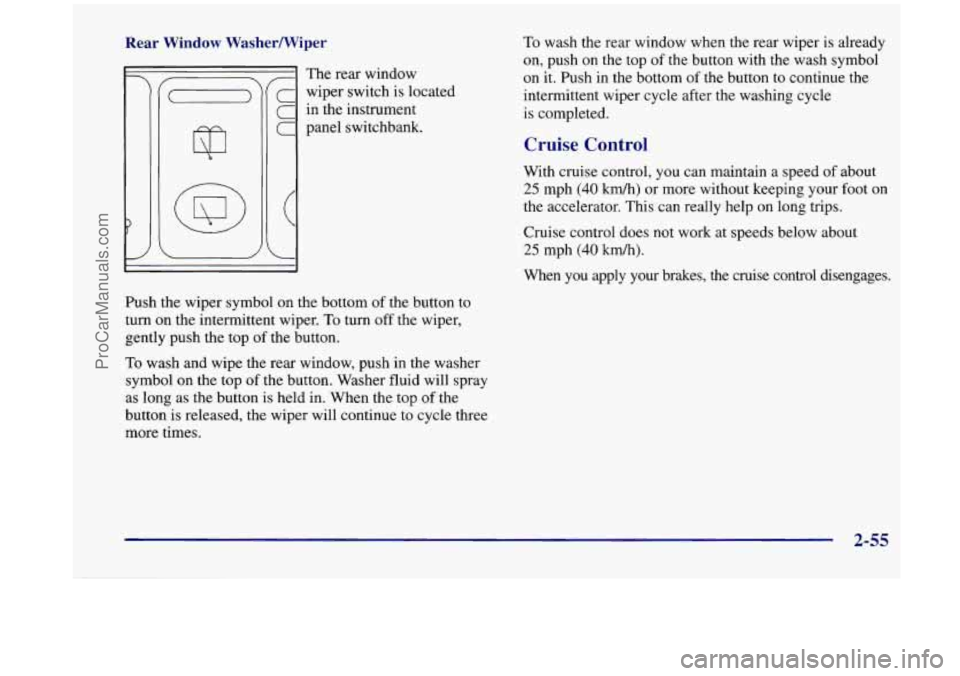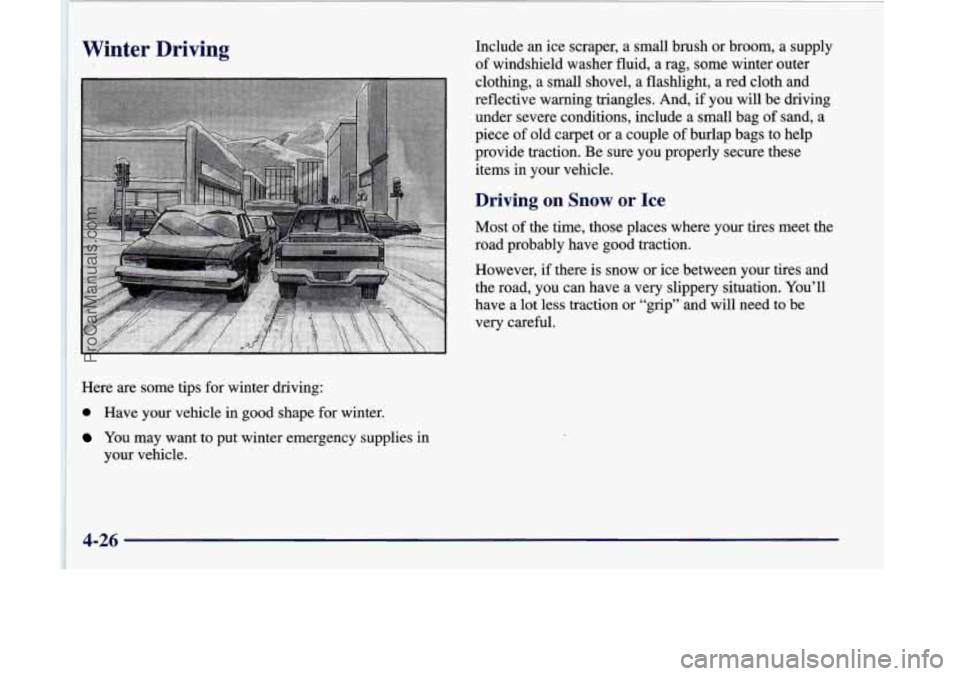washer fluid OLDSMOBILE SILHOUETTE 1998 Owners Manual
[x] Cancel search | Manufacturer: OLDSMOBILE, Model Year: 1998, Model line: SILHOUETTE, Model: OLDSMOBILE SILHOUETTE 1998Pages: 444, PDF Size: 23.2 MB
Page 156 of 444

Windshield Wipers Windshield Washer
You control the windshield wipers by turning the band
marked
WIPER.
For a single wiping cycle, turn the band to MIST. Hold
it there until the wipers start, then let go. The wipers will
stop after one cycle.
If you want more cycles, hold the
band on mist longer.
For delayed wiping cycles, you can set the wiper speed
for a long or short delay between wipes. This can be
very useful in light rain or snow. Turn the band to
choose the delay time. The closer to LOW, the shorter
the delay time.
For steady wiping cycles, at low speed, turn the band
away from you to the
LOW position. For high-speed
wiping, turn the band further to
HIGH. To stop the
wipers, move the band to
OFF.
Remember that damaged wiper blades may prevent you
from seeing well enough to drive safely. To avoid damage,
be sure to clear ice and snow
fiom the wiper blades before
using them.
If they’re frozen to the windshield, carefidly
loosen or thaw them.
If your blades do become damaged,
get new blades or blade inserts.
Heavy snow or ice can overload your wipers.
A circuit
breaker will stop them until the motor cools. Clear away
snow or ice to prevent an overload. To
wash your windshield, press and hold the windshield
washer paddle. The washers and wipers will operate.
When you release the paddle, the washers will stop, and
the wipers will continue to operate for two cycles, unless
your wipers had already been on. In that case, the wipers
will resume the wiper speed you had selected
earl+.
In freezing weather, don’t use your washer until
the windshield is warmed. Otherwise the washer
fluid can form ice on the windshield, blocking
your vision.
2-54
ProCarManuals.com
Page 157 of 444

Rear Window Washermiper
7
C
C
C
(
L
The rear window
wiper switch is located
in the instrument
panel switchbank.
I
Push the wiper symbol on the bottom of the button to
turn on the intermittent wiper. To turn
off the wiper,
gently push the top
of the button.
To wash and wipe the rear window, push in the washer
symbol on the top of the button. Washer fluid will spray
as long as the button is held in. When the top of the
button is released, the wiper will continue to cycle three
more times. To
wash the rear window when the rear wiper
is already
on, push on the top
of the button with the wash symbol
on it. Push in the bottom
of the button to continue the
intermittent wiper cycle after the washing cycle
is completed.
Cruise Control
With cruise control, you can maintain a speed of about
25 mph (40 kdh) or more without keeping your foot on
the accelerator. This can really help on long trips.
Cruise control does not work at speeds below about
25 mph (40 km/h).
When you apply your brakes, the cruise control disengages.
2-55
ProCarManuals.com
Page 250 of 444

Driving in Rain and on Wet Roads Rain and wet roads can mean driving trouble. On a wet
road, you can’t stop, accelerate or
turn as well because
your tire-to-road traction isn’t as good
as on dry roads.
And, if your tires don’t have much tread left, you’ll get
even less traction. It’s always wise to go slower and be
cautious
if rain starts to fall while you are driving. The
surface may get wet suddenly when your reflexes are
tuned for driving on dry pavement.
The heavier the rain, the harder it is to see. Even if your
windshield wiper blades are in good shape, a heavy rain
can make
it harder to see road signs and traffic signals,
pavement markings, the edge of the road and even
people walking.
It’s wise to keep your wiping equipment in good shape
and keep your windshield washer tank filled with
washer fluid. Replace your windshield wiper inserts
when they show signs of streaking
or missing areas on
the windshield, or when strips of rubber start to separate
from the inserts.
4-18
ProCarManuals.com
Page 255 of 444

The exit speed is usually posted.
Reduce your speed according to your speedometer, not
to your sense of motion. After driving for any distance
at higher speeds, you may tend to think you are going
slower than you actually are.
Before Leaving on a Long Trip
Make sure you’re ready. Try to be well rested. If you
must start when you’re not fresh
-- such as after a day’s
work
-- don’t plan to make too many miles that first part
of the journey. Wear comfortable clothing and shoes
you
can easily drive in.
Is your vehicle ready for a long trip? If you keep it
serviced and maintained, it’s ready to go. If it needs
service, have it done before starting out. Of course,
you’ll find experienced and able service experts in
Oldsmobile retail facilities all across North America.
They’ll be ready and willing to help if you need it. Here
are some things you can check before
a trip:
0
0
0
0
0
0
0
Windshield Washer Fluid: Is the reservoir full? Are
all windows clean inside and outside?
Wiper Blades: Are they in good shape?
Fuel, Engine Oil, Other Fluids: Have you checked
all levels?
Lamps: Are they all working? Are the lenses clean?
Tires: They are vitally important to a safe,
trouble-free trip.
Is the tread good enough for
long-distance driving? Are the tires all inflated to the
recommended pressure?
Weather Forecasts: What’s the weather outlook
along your route? Should you delay your trip a short
time
to avoid a major storm system?
Maps: Do you have up-to-date maps?
ProCarManuals.com
Page 258 of 444

I
Winter Driving Include an ice scraper, a small brush or broom, a supply
of windshield washer fluid, a rag, some winter outer
clothing,
a small shovel, a flashlight, a red cloth and
reflective warning triangles. And, if you will be driving
under severe conditions, include
a small bag of sand, a
piece of old carpet or a couple
of burlap bags to help
provide traction. Be sure you properly secure these
items in your vehicle.
Driving on Snow or Ice
Here are some tips for winter driving:
0 Have your vehicle in good shape for winter. Most
of the time, those places where your tires
meet the
road probably have good traction.
However,
if there is snow or ice between your tires and
the road, you can have a very slippery situation. You’ll
have
a lot less traction or “grip” and will need to be
very careful.
I You may want to put winter emergency supplies in
your vehicle.
ProCarManuals.com
Page 311 of 444

Section 6 Service and Appearance Care
Here you will find information about the care of your vehicle. This section begins with service and fuel information,
and then it shows how to check important fluid and lubricant levels. There
is also technical information about your
vehicle, and a part devoted to its appearance care.
6-2 6-3
6-7
6-8
6-1
1
6-15
6- 16
6-18
6-2 1
6-24
6-26
6-27
6-30
6-3 1
6-38 Service
Fuel
Filling a Portable Fuel Container
Checking Things Under the Hood
Engine Oil
Air Cleaner
Passenger Compartment Air Filter
Replacement
Automatic Transaxle Fluid
Engine Coolant Radiator Pressure Cap
Windshield Washer Fluid
Brakes
Battery
Bulb Replacement
Windshield Wiper Blade Replacement 6-39
6-47
6-47
6-50
6-53
6-53
6-54
6-55
6-56
6-64
6-64
6-64
6-65
6-65
6-65 Tires
Appearance Care
Cleaning the Inside
of Your Vehicle
Cleaning the Outside of Your Vehicle
Underbody Maintenance
Chemical Paint Spotting
Appearance Care Materials Chart
Vehicle Identification Number (VIN)
Electrical System
Replacement Bulbs Capacities and Specifications
Engine Specifications
Vehicle Dimensions
Normal Maintenance Replacement Parts
Air Conditioning Refrigerants
6-1
ProCarManuals.com
Page 318 of 444

Checking Things Under the Hood
I
A CAUTION: I
An electric fan under the hood can start up and
injure you even when the engine is not running.
Keep hands, clothing and tools away from any
underhood electric fan.
I
L
A CAUTION:
I
Things that burn can get on hot engine parts and
start a fire. These include liquids like gasoline,
oil, coolant, brake fluid, windshield washer and
other fluids, and plastic or rubber. You or others
could be burned. Be careful not to drop or spill
things that will burn onto a hot engine.
Hood Release
To open the hood, first pull the hood release handle
inside the vehicle.
6-8
ProCarManuals.com
Page 320 of 444

When you lift the hood, you'll see these items:
T
A.
B.
C. Underhood Fuse and
D.
Relay Center E.
Remote Positive (+) Terminal E
Windshield
Washer G.
Fluid Reservoir Radiator
Pressure Cap
H. Transaxle Fluid Dipstick
Power Steering Fluid Reservoir
I. Brake Master Cylinder
Engine
Oil Fill Location J. Air Cleaner
Engine Oil Dipstick
IS. Engine Coolant Reservoir
6-10
ProCarManuals.com
Page 335 of 444

Power Steering Fluid
The power steering fluid reservoir is located to the right
of the windshield washer fluid reservoir, at the back of
the engine compartment.
When to Check Power Steering Fluid
It is not necessary to regularly check power steering
fluid unless
you suspect there is a leak in the system or
you hear an unusual noise.
A fluid loss in this system
could indicate a problem. Have the system inspected
and repaired.
How To Check Power Steering Fluid
When the engine compartment is cool, wipe the cap and
the top
of the reservoir clean, then unscrew the cap and
wipe the dipstick with a clean rag. Replace the cap and
completely tighten
it. Then remove the cap again and
look at the fluid level on the dipstick.
When the engine compartment is hot,
the level should
be at the
“H” mark. When it’s cold, the level should be
at the
“C” mark. If the fluid is at the ADD mark, you
should add fluid.
What to Use
To determine what lund of fluid to use, see
“Recommended Fluids and Lubricants” in the Index.
Always use the proper fluid. Failure to use the proper
fluid can cause leaks and damage hoses and seals.
6-25
ProCarManuals.com
Page 336 of 444

Windshield Washer Fluid
What to Use
When you need windshield washer fluid, be sure to read
the manufacturer’s instructions before use. If you will
be
operating your vehicle in an area where the temperature
may fall below freezing, use a fluid that has sufficient
protection against freezing.
Adding Washer Fluid
The windshield washer
fluid reservoir is located on
the passenger’s side
of the
vehicle, near the fuse and
relay center.
NOTICE:
Open the cap labeled WASHER FLUID ONLY. Add
washer fluid until the tank
is full.
0
0
0
0
When using concentrated washer fluid,
follow the manufacturer’s instructions for
adding water.
Don’t mix water with ready-to-use washer
fluid. Water can cause the solution to freeze and damage your washer fluid tank and
other parts of the washer system.
Also,
water doesn’t clean as well as washer fluid.
Fill your washer fluid tank only
three-quarters full when it’s very cold.
This allows
for expansion if freezing occurs,
which could damage the tank if it is
completely full.
Don’t use engine coolant (antifreeze) in
your windshield washer. It can damage
your washer system and paint.
6-26
ProCarManuals.com